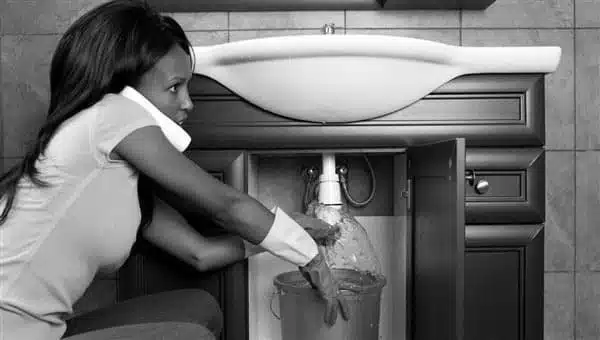Congratulations on your new home! While it’s undoubtedly an exciting time, it also brings with it a new set of responsibilities, including maintaining the plumbing system of your house. Fear not, dear reader! You don’t need to be a seasoned plumber to detect water leaks. In this guide, we’ll walk you through checking water leaks using the city meter, and how to check for leaks at toilets, tubs, showers, and faucets.
Table of Contents
How to Use the City Meter to Check for Leaks
Your city water meter isn’t just for tracking your usage, it’s also a secret weapon when checking water leaks. Let’s put it to work! Before you start, make sure all the water-consuming appliances and faucets are turned off in your home. Now, it’s time to find your water meter. Typically, it’s housed in a concrete box near the street or sidewalk.
Take note of the current reading on the meter, then play the waiting game. Try to avoid using water in your home for the next hour. Yes, it’s tough, but it’s essential for our mission here. After the hour has passed, go back to the meter and note down the reading again.
If the meter shows a higher reading than before, it’s like a red flag waving at you – there could be a leak lurking somewhere in your home. This is your cue to roll up your sleeves and start investigating further. Whether it’s a dripping faucet, a leaking toilet, or a mystery puddle, armed with this information, you’re one step closer to maintaining your home’s plumbing like a pro!
Identifying Toilet Water Leaks
A stealthy water waster in your home could be a leaking toilet. But worry not, discovering if your toilet is playing this sly game is a pretty simple task. Kick start your detective work by removing the lid from the toilet tank. Now, it’s time for a splash of color. Add a couple of drops of food coloring to the water in the tank. Resist the urge to flush for the next 30 minutes. Why, you ask? The food coloring will work as a tracer, and any leakage will be revealed.
After the wait, it’s showtime. Check the water in your toilet bowl. If you spot the color you added to the tank now in the bowl, we have a winner – or a loser, depending on how you see it. You’ve got a leak! The colored water has made its escape from the tank to the bowl without a flush, indicating a problem. Armed with this knowledge, you’re ready to tackle this issue head-on and save your home from unnecessary water wastage. Now, wasn’t that easy?

How to Check for Leaks in Tubs and Showers
Diving into the world of tub and shower leaks, let’s start with a little detective work. Begin your search by scanning the areas where your tub or shower makes contact with the floor and walls. Notice any wallpaper or paint peeling off? What about spots of mold or mildew? These could be telltale signs of a water leak.
Now, let’s switch to practical mode. Plug the drain and pour a bit of water into your tub or shower. Don’t forget to mark the water level. Time to play the waiting game again. Leave it for a few hours. The suspense might kill you, but it’s worth it. After the clock has ticked away, it’s time to check back. If the water level has dropped from your mark, then voila, we’ve got a leak.
The Sherlock in you has now uncovered another potential source of water wastage in your home. Armed with this knowledge, you’re ready to move on to the next step: repair and prevention. Happy sleuthing, my water-conscious friend!
Related Content: Water Line Repair
Checking Water Leaks in Faucets
The trickling symphony of a leaking faucet is hard to miss, but there’s more to checking water leaks in faucets than just that telltale sound. Start your investigation by tuning into any unusual dripping noises when the faucet is off. Pay attention to any unwanted puddles around the faucet base – they could be singing the tune of a potential leak.
Don’t stop your detective work at the surface level! For a thorough investigation, dare to venture beneath the sink. Open the cabinet doors and give it a good look. Keep your eyes peeled for any signs of water damage. Dark stains, a musty smell, or even signs of mildew could all point towards a sneaky leak that’s been dripping in the dark.
Remember, it’s the little things that often make a big difference. Faucet leaks might seem small, but they can add up to a significant water wastage over time. By putting your detective skills to work, you’re taking a giant step towards a more water-efficient home. So here’s to your newfound skill, and happy leak hunting!
Related Content: Repairing Ceiling Leaks
Preventative Measures and Regular Checks
Proactive upkeep and routine inspections are like the secret sauce for a leak-free home. Think of it as giving your house a regular health check-up. From the external walls to the foundation, a keen eye can spot early signs of water leaks. That slight dampness on the wall or the tiny puddle under the outdoor faucet might be your home’s SOS signal.
Don’t underestimate the power of insulation either. When winter rolls around, your pipes can catch a serious case of the chills, risking a freeze and possible burst scenario. Insulating them is like offering a warm winter coat – it safeguards them from the harsh cold and helps you avoid a full-blown plumbing catastrophe.
And let’s not forget about fixtures. They may look innocent but old or worn-out fixtures are like ticking time bombs, waiting to spring a leak when you least expect it. So don’t hesitate to show them the exit door before they start causing trouble.
While you’re at it, become a regular at your local hardware store. Stock up on essential plumbing tools and supplies. That way, when a leak does occur, you’ll be ready to jump into action, toolbox in hand.
FAQs
How do you check for a water leak in your house?
If the dial is in motion, it is highly likely that there is a leak present. Alternatively, you may opt to record a meter reading, refrain from using any water for a duration of 1 to 2 hours, and then record another meter reading. If the reading has altered, it indicates the presence of a leak.
How do you know if pipes are leaking under house?
Indications of a leaky pipe can be observed through distorted flooring, wallpaper that is peeling, and water stains on the ceiling. Indications of a leak beneath your floor include the presence of unforeseen damp carpets or pools of water.
Can you have a water leak and not know?
Approximately 12% of households experience an unnoticed water leakage, resulting in a daily loss of approximately 80-90 gallons of water. No one desires financial losses resulting from water pipe issues, let alone the potential property damage that a leak could cause, amounting to thousands of dollars.
Conclusion
Keeping your home leak-free isn’t just about playing detective; it’s about donning the hat of a guardian too. A proactive approach coupled with regular inspections can save you gallons of water, not to mention, substantial repair costs. So here’s a toast to your proactive stance towards a more water-efficient, happier home!
